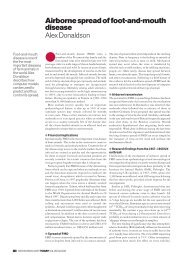Download - Society for General Microbiology
Download - Society for General Microbiology
Download - Society for General Microbiology
You also want an ePaper? Increase the reach of your titles
YUMPU automatically turns print PDFs into web optimized ePapers that Google loves.
An inside job:<br />
Bdellovibrio<br />
bacteriovorus<br />
Some predatory ‘bugs’ eat other ‘bugs’ from inside,<br />
as Liz Sockett and her research group have found.<br />
Bdellovibrio are small (0.25×<br />
1.0 μm), flagellate, motile,<br />
Gram-negative deltaproteobacteria<br />
which invade<br />
and kill other Gram-negative<br />
bacteria, entering the<br />
prey cell’s periplasm, replicating within<br />
it and using the contents of that<br />
bacterium as their nutrient source.<br />
Bdellovibrio bacteriovorus HD100 is the<br />
sequenced strain and has a 3.8 Mb genome,<br />
indicating that although Bdellovibrio<br />
have evolved to invade and<br />
‘eat’ other bacteria, they have not lost<br />
large numbers of genes, as is the case<br />
with truly parasitic bacteria which rely<br />
on their hosts. The interaction between<br />
Bdellovibrio and other bacteria can be<br />
thought of as predatory rather than<br />
parasitic as, in most cases, the Bdellovibrio<br />
kill the prey cell within 15 minutes<br />
of entry and do not establish a longlived<br />
parasitic relationship within it.<br />
In keeping with its large genome,<br />
B. bacteriovorus can exist in two different<br />
growth phases, as host-dependent<br />
(HD) cells that require prey <strong>for</strong> growth<br />
and division, and as host-independent<br />
(HI) cells, when growing in rich nutrient<br />
media as might be found in biofilms<br />
and sediments in nature. The<br />
balance between HD and HI growth<br />
in natural environments is not known,<br />
but HI growth is a useful tool <strong>for</strong> saving<br />
non-predatory mutants <strong>for</strong> study in the<br />
lab setting. Predatory growth seems to<br />
be a kind of evolutionary trade-off in<br />
Bdellovibrio where the acquisition of a large number of genes<br />
<strong>for</strong> hydrolytic enzymes, and <strong>for</strong> penetrating and resealing<br />
the prey cell, give access to an intracellular niche, bounded<br />
by the prey-cell outer membrane, where the Bdellovibrio can<br />
‘dine privately’ on the inner contents of the prey cell without<br />
competition <strong>for</strong> nutrients from other bacteria. This contrasts<br />
with the ‘eating habits’ of other deltaproteobacteria such<br />
as the myxobacteria which digest prey externally and take<br />
up digested prey nutrients partly in competition with other<br />
bacteria in their surroundings.<br />
m Bdellovibrio life cycle, showing predatory (HD) and (rarer)<br />
axenic (HI) growth modes. Liz Sockett<br />
b False-coloured, negatively stained electron micrograph of a<br />
B. bacteriovorus bdelloplast. David Milner and Laura Hobley<br />
Predatory growth<br />
When growing predatorily, Bdellovibrio exhibit a biphasic lifestyle<br />
with a free-swimming attack phase and a sessile intraperiplasmic<br />
growth phase, during which they reside inside the<br />
dead prey cell, degrading it by secreting enzymes across the<br />
prey cytoplasmic membrane to digest prey macromolecules,<br />
and taking up the products <strong>for</strong> Bdellovibrio growth. Bdellovibrio<br />
seem to be mostly ‘locked on’ to predatory growth in dilute<br />
environments and cannot productively switch to HI growth to<br />
survive, but depend on finding prey <strong>for</strong> replication. During the<br />
free-swimming attack phase, rapid prey location, attachment<br />
and recognition are vital to the successful replication of the<br />
Bdellovibrio, as they typically have a half-life of about 10<br />
hours during starvation in buffered environments. A large<br />
complement of genes <strong>for</strong> flagellar and chemotaxis systems<br />
is seen in the genome to aid movement towards prey-rich<br />
regions.<br />
184 microbiology today nov 08 microbiology today nov 08 185
















